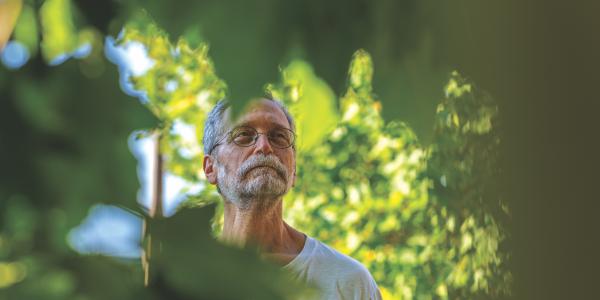Stan Braude, a professor of practice in biology and environmental studies, died on June 1, 2024, after a short illness. A beloved teacher, colleague, and mentor, Braude was a world expert on naked mole-rat ecology, evolution, and behavior in the wild.
Braude was active in research projects sponsored by the Living Earth Collaborative, the Institute for Public Health, and Tyson Research Center. Certified as an EMT, wilderness medicine educator, and arborist, he was also the first curator of the WashU arboretum.
We asked a few of Braude’s colleagues and students to share their favorite memories.

It is difficult to capture in a few sentences how much Stan Braude means to the biology department, WashU, and the St. Louis community. He made so many contributions to our lives, both in and out of the classroom. I am grateful that there are many signs of Stan’s creativity and passion for teaching and sharing around campus. One example I see every day on my way to my office is the outdoor classroom near Bayer Lab. This is where Stan would meet with the students of his “Woody Plants of Missouri” class. This outdoor classroom may have initially come about as a creative (perhaps desperate) solution to allow Stan to teach in person during the COVID-19 pandemic. But even after the health precautions were loosened, this space became the meeting place for his class. More recently, the whiteboard of this classroom has become an informal memorial to Stan. I hope that the outdoor classroom, the Arboretum, and all the fun stories and memories about Stan remain with us for a long, long time.
— Barbara Kunkel, professor of biology
Most of us who knew Stan knew he was a collector of anything and everything that could be useful for his hobbies or those of the people around him. So, when I took up making paper without any of the proper tools, I asked Stan if I could borrow the paper cutter I’d seen stashed in his office. Instead of loaning it to me for the weekend as I’d asked, he said he was giving it to me on a 100-year loan — which he later clarified meant forever. A few days later, he followed up and I was happy to tell him that, thanks to him, I was no longer only producing circular paper. He took additional interest in my search for natural, light-fast pigments and immediately suggested people I should reach out to for ideas. It was a simple act of sharing information but, in that moment, I recognized how much joy he found in the things that those around him enjoyed, and how much he loved to connect people. This short conversation is one of the clearest examples I have that knowing Stan meant being valued and supported by him and by an invisible army of friends and colleagues he was always ready to call upon for your sake.
— Alayna Mickles, BA ‘23
Every spring, Stan led a fishing trip for the students who took his “Missouri’s Natural Heritage” course and any graduate students who TA’ed for him. I had agreed to go, but the week leading up to the trip I was very stressed — about what, I can’t remember — and I saw that the weather forecast was supposed to be freezing. I emailed him saying I didn’t have it in me to make the trip and I hoped to join in future years when the weather wasn’t so cold. He responded with an original haiku:
“You’re smarter than me
I’m sure I’ll regret it
Unless I catch fish”
Stan frequently sent poems to me and other plant enthusiasts. Now, I would like to offer a poem of my own:
I am grateful for Stan,
Who for years collected knowledge, stories, and joy.
I thank him for sharing that with us,
For cooking us food,
For giving us clothes and sleeping bags to keep us warm,
And for brightening our evenings around the fire.
I can only hope to release that much warmth and light in return.
— Anna Wassel, graduate student
My favorite memory of Stan is a recent one. Last August, as I was walking through the South 40 after dropping my daughter off for her first day of college, I ran into him. He was posting signs highlighting the campus as an arboretum. Stan could have just waved but, instead, he stopped and asked if I had ever tasted a pawpaw. I had not. He placed a pawpaw, still warm from the sun, in my hand. He told me to smell it — it smelled wonderful — and to try it when I got home. He told me that although pawpaws are tropical in smell and taste, they are native trees. I was so thrilled that I showed my pawpaw to other parents in my daughter’s dorm and told them what Stan had shared. I then went home and shared the story with my family. To me, this encounter embodies Stan as a person and a teacher. Kind-hearted and knowledgeable about topics ranging from pawpaws to naked mole-rats to the genetics of dogs, he used his gifts to help people appreciate the world around them just a little bit more.
— Petra Levin, the George William and Irene Koechig Freiberg Professor of Biology





